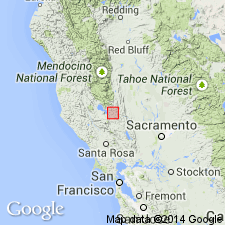
- Usage in publication:
-
- Kelsey Tuff Member*
- Modifications:
-
- Named
- Dominant lithology:
-
- Tuff
- AAPG geologic province:
-
- California Coast Ranges province
Summary:
Named as member within Kelseyville Formation for exposures in Kelsey Creek and along HWY 29. Measured type section is designated as exposures in roadcut along HWY 29, 3.4 km south-southeast of Kelseyville, SE/4 NE/4 sec.26 T13N R9W, Kelseyville 7.5' quad, Lake Co, CA. Shown on geologic sketch map. Referred to as "volcanic-ash aquifer" and "aquifer ash" and described as dacitic to andesitic lithic-tuff in unpub. report of Lake County Flood Control and Water Conservation District (1967). Because of its distinctive character and its presence throughout much of Big Valley, it is useful as a marker bed. Consists of lower unit (20 to 30 cm thick) composed of several thin beds that range from light-gray to yellowish gray and from fine-grained vitric tuff to coarser, lithic tuff. Consists of upper unit (120 to 170 cm thick) which is unsorted bed of gray to yellowish gray, pumiceous, basaltic andesitic lapilli tuff. Age of Kelseyville Formation is Pleistocene based on fossil flora and approximate isotopic ages (younger than 0.64 Ma).
Source: GNU records (USGS DDS-6; Menlo GNULEX).
For more information, please contact Nancy Stamm, Geologic Names Committee Secretary.
Asterisk (*) indicates published by U.S. Geological Survey authors.
"No current usage" (†) implies that a name has been abandoned or has fallen into disuse. Former usage and, if known, replacement name given in parentheses ( ).
Slash (/) indicates name conflicts with nomenclatural guidelines (CSN, 1933; ACSN, 1961, 1970; NACSN, 1983, 2005, 2021). May be explained within brackets ([ ]).

